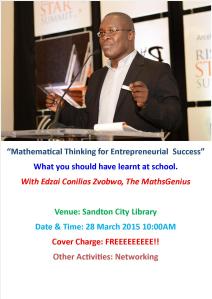Innovative Mathematical Thinking
by Keith Devlin
We read all the time how poorly the US mathematics education system performs compared with other nations, particularly those we compete with economically. The most cited comparison study on which this dire conclusion is reached is PISA, short for Programme for International Student Assessment, organized by the Organization for Economic Cooperation and Development (OECD).
The PISA tests are administered in schools every three years to 15-year-olds, and cover mathematics, science, and reading literacy and problem-solving skills. The main focus of the first (PISA 2000) was reading, the second (PISA 2003) mathematics, and the most recent (PISA 2006) science. (Data for the assessment that took place in 2009 will be released in December of this year.) Tests are typically administered to between 4,500 and 10,000 students in each country.
Six countries have consistently made it to the top ten: Finland, Canada, Japan, Netherlands, Australia, and New Zealand. (Singapore, which also has a very successful mathematics education system that is frequently cited, does not participate in PISA.)
In PISA 2003, out of the 30 countries in the OECD, the United States ranked 18th in mathematics, 22nd in science, and 28th in reading literacy and problem solving. In 2006, American students ranked dead last, 25th out of 25, in math and 21st out of 30 in science. The US also scored worse than ranked countries outside the OECD (considered to be developing nations) like Russia, Azerbaijan, Slovenia, and Estonia. Only 1 percent of American 15-year-olds could perform at the highest level, and 27 countries had a higher percentage of 15-year-olds who performed at level 6. And 28 percent of US students appear to have essentially no math skills at all.
The release of each new set of PISA results produces predictable rallying cries from politicians to “turn things around” and “put the US back at the top.” But is this realistic? And perhaps more to the point, what does it mean to be “at the top”?
At the top in what?
In terms of sheer numbers, which is the statistic of most interest to the leaders of large corporations who are faced with hiring enough mathematically-qualified employees, we cannot hope to keep up with China (population of 1.3 billion) or India (population 1.1 billion). In both countries there is enormous pressure on children to secure a good education leading to a secure future, both parental and self-motivational, and that will inevitably produce more and more highly able mathematicians, scientists, and engineers. Will the US, with a total population of 300 million (less than a third of each of those two giants), produce individuals equal to those from China and India. Of course we will; no nation has all the world’s human talent. But in terms of the overall numbers, there is no way we will be able to keep up. So if being at the top means we produce more well qualified, able mathematical citizens than any other country, we cannot possibly succeed.
Or does being a “at the top” mean that US students will be at or near the top in international rankings such as PISA, which is the statistic that politicians seem to care most about? I seriously doubt we can achieve that. All those countries I listed that come out near the top are much smaller and cohesive than the US, and have generated systemic change in a way that our size and structure renders impossible.
To take one example, if you look at the country that came out at the very top in math on the last the PISA assessment, Finland, you find it has an educational system and societal values very different from the US:
- Teachers are extremely well trained to high national certification standards, including content knowledge;
- Only the best qualified applicants are admitted to education school, through a highly competitive process;
- Teachers are paid a salary comparable to an engineer or a doctor;
- Teaching is a highly regarded profession that many aspire to;
- Teaching really is a profession, complete with peer development, regular in-service training, etc., not just a job.
By contrast, in the US: (1) some states have tried to demand this only to find that there are no teachers available with many leaving the profession within five years; (2) fewer and fewer students are entering the teaching profession and typically there is little or no encouragement in academic departments on campus for teachers at any level including graduate school; (3) teachers’ salaries are very low compared with other professions; (4) teaching is not valued and there is almost no encouragement for those entering the profession; and (5) professional development is required but is rarely academically oriented toward content; social issues have taken precedent in many schools.
You can, of course, lament this state of affairs all you want, but that is the playing field on which those of us with a stake in US education have to operate. So if we really want to change things (rather than just score political points and advance careers by empty rhetoric) let’s work with what we’ve got. As one of the most innovative and resourceful nations on Earth, we might just find that, in the process, we find ourselves once more in a leadership role.
The first thing we should do is admit that the existing approach simply does not work for us, and there is no way it can be made to work. Then we need to step back and take a fresh look at the situation. What exactly do we want to occur and why?
Today’s need: the innovative mathematical thinker
I’ll admit that I would like to see us adopt an education system like those in Finland or Singapore, having the features I listed above. But even if we could – and as I already indicated, I do not think it would be possible in the US – I don’t think it would be enough any more. The world has changed. In the words of author Thomas Friedman today’s world is (economically) flat. (The World Is Flat: A Brief History of the Twenty-First Century) Focusing entirely on the business and commercial worlds, traditional mathematical tasks can be outsourced even more easily than manufacturing, at electron speed with virtually no shipping cost. A designer in New York or San Francisco who wants a certain set of equations solved can simply email them to a specialist center in India and the answer will be emailed back by the next morning.
Faced with that economic reality, the only viable response for the US is to do what it has for the past century, and what we have already done with manufacturing, and stay ahead of the curve as the world’s main innovation engine. Just how long this strategy will work is hard to predict – the future usually is – but I don’t think we have a better choice.
For many years, we have grown accustomed to the fact that advancement in an industrial society required a workforce that has mathematical skills. But if you look more closely, those skills fall into two categories. The first category comprises people who can take a new problem, say in manufacturing, identify and describe key features of the problem mathematically, and use that mathematical description to analyze the problem in a precise fashion. The second category comprises people who, given a mathematical problem (i.e., a problem already formulated in mathematical terms), can find its mathematical solution.
Hitherto, our mathematics education process has focused primarily on producing people of the second variety. As it turned out, some of those people always turned out to be good at the first kind of activities as well, and as a nation we did very well. But in today’s world, and the more so tomorrow’s, with a growing supply of type 2 mathematical people in other countries – a supply that will soon outnumber our own by an order of magnitude – our only viable strategy is to focus on the first kind of ability, and hope we can hold our own in that category.
In other words, the only mathematical niche I can see for the US – and, fortunately for us, it is a crucial niche in today’s world economy – is at the innovation end. Fortunately, innovation is an area where we still lead the world, in large part because our political system allows and rewards innovation, and also because it is very much a part of the American character.
(In case that last statement comes across as being American-centric, note that it surely is simply a reflection of our history. For several centuries, and particularly the last century, some of the most innovative people from around the world have flocked to our shores to make their fortune – or in many cases simply to survive. We have a culture of, and a liking for, innovation because that was one of the consequences of large-scale immigration. We took in many of the world’s innovators, taking advantage of the fact that one country’s troublemaker can be another’s innovator!)
Traditionally, a mathematician had to acquire mastery of a range of mathematical techniques, and be able to work alone for long periods, deeply focused on a specific mathematical problem. Doubtless there will continue to be native-born Americans who are attracted to that activity, and our education system should support them. We definitely need such individuals. But our future lies elsewhere, in producing mathematical thinkers that fall into my first category above: what I propose to call the innovative mathematical thinkers.
In order to exhibit the abilities I listed in category 1 above, this new breed of individuals (well, it’s not new, I just don’t think anyone has shone a spotlight on them before) will need to have, above all else, a good conceptual (in a functional sense) understanding of mathematics, its power, its scope, when and how it can be applied, and its limitations. They will also have to have a solid mastery of basic mathematical skills, but it does not have to be stellar. A far more important requirement is that they can work well in teams, often cross-disciplinary teams, they can see things in new ways, they can quickly come up to speed on a new technique that seems to be required, and they are very good at adapting old methods to new situations.
It should go without saying that possibly the worst way to educate such individuals is to force them through a traditional mathematics curriculum, with students working alone through a linear sequence of discrete mathematical topics. To produce the twenty-first century innovative mathematical thinker, you need project-based, group learning in which teams of students are presented with realistic problems that will require mathematical and other kinds of thinking for their solution.
Of course, you still need a curriculum, in the sense of a list of topics that students need to master at some point or other. What you do not want to do is proceed through it one topic after another as is current practice in the US. A common complaint about our current, topic-by-topic, curriculum-based approach to mathematics education is that it is “a mile wide and an inch deep.” It’s not that we teach more topics overall than, say, Finland or Singapore. Rather, we try to cover too many in a single year. The countries that perform well in PISA teach far fewer topics each year, but to a far greater depth. Instead of repeating many topics year after year, those countries merely provide revision of material learned well the previous year, and focus on new topics. A well thought out project-based approach could eliminate the mile-wide, inch-deep problem as well.
The (new) role of the teacher
In the educational scenario I am describing, the teacher’s role is much more important than in the traditional system. In fact, technology has now rendered obsolete much of what teachers used to do. Except on rare occasions, today’s teacher should not be spending much time at the board explaining basic techniques. That form of instruction can now be found in videos and interactive instruction materials on the Web, much of it for free, where the student can proceed at her or his own pace, free from unwanted distractions by other students, and can stop the video at any moment, view a single frame for as long as required, and replay a segment as many times as necessary. Moreover, increasingly, such materials are being offered in a package that tracks each student’s progress and delivers new material at a rate that matches the student’s ability and past performance. (The non-profit Khan Academy is an example of such a resource that has garnered a lot of attention of late.)
This frees the teacher from being a very expensive delivery system that ships facts from textbooks into students’ notebooks (and hopefully into the students’ minds as well), to being a full-service learning resource. Teachers can diagnose what students understand already, including their typical misunderstandings, they can offer alternative representations, counter examples, examples to help make things clearer when they have had feedback from students, they can explain misconceptions, and they can put students in situations where they have to pay attention to a new idea.
I am not saying the teacher will never stand at the board and provide instruction. A well-designed class lesson can be extremely useful. For example, some of the best designed lessons in Japan and China and Singapore can be very effective, because they draw on what students already know and anticipate plausible misconceptions that can be genuinely constructed by thinking.
But overall, modern technology changes the balance between the different activities dramatically. In the traditional approach, students were supposed to acquire new facts and learn new techniques in class, and then practice them at home. In the twenty-first century educational system, these two can be, and in my view should be, completely interchanged: home is the primary location where the student acquires the facts and learns the methods (mostly from the Web), the classroom is where, with the help of other students and the all-important teacher, the student works through exercises to gain understanding, with the teacher engaging in all the activities I listed a moment ago.
With class projects driving the entire process, it is quite likely that different students will access different material at different times, in different orders, as each team tries their own approach. In the traditional educational model, no teacher could handle that kind of information delivery load, but Web videos take care of that with ease. The “facts of math” are few. What takes time and effort is learning how to make good use of those facts – learning how to think mathematically – and that is where there is no substitute for a good (human) teacher. That’s what today’s teacher should focus her or his time on.
The leadership role that the US has been used to, and clearly wants to maintain, is to be found, I suggest, in the growing strategic importance (particularly to the US) of innovative mathematical thinking, to give a name to the kind of activity I have described above. This is where our economic future lies as a nation. And that is what our educational system needs to embrace. It is an educational philosophy that our local-control, bottom-up, free-enterprise, federated social and governmental structures, and let me add our national character, are particularly well suited to. What we should be doing is not teaching the mathematics for the industrial age, but developing in our students the kind of free-thinking, novel ways of thinking about problems, making use of mathematics when required or appropriate, that are necessary in a nation whose economic well being depends upon constantly innovating.
Devlin’s Angle is updated at the beginning of each month. Find more columns here. Follow Keith Devlin on Twitter at @profkeithdevlin.
Mathematician Keith Devlin (email: devlin@stanford.edu) is the Executive Director of the Human-Sciences and Technologies Advanced Research Institute (H-STAR) at Stanford University and The Math Guy on NPR’s Weekend Edition. His most recent book for a general reader is The Unfinished Game: Pascal, Fermat, and the Seventeenth-Century Letter that Made the World Modern, published by Basic Books.
source:
Share this with your friends:





























